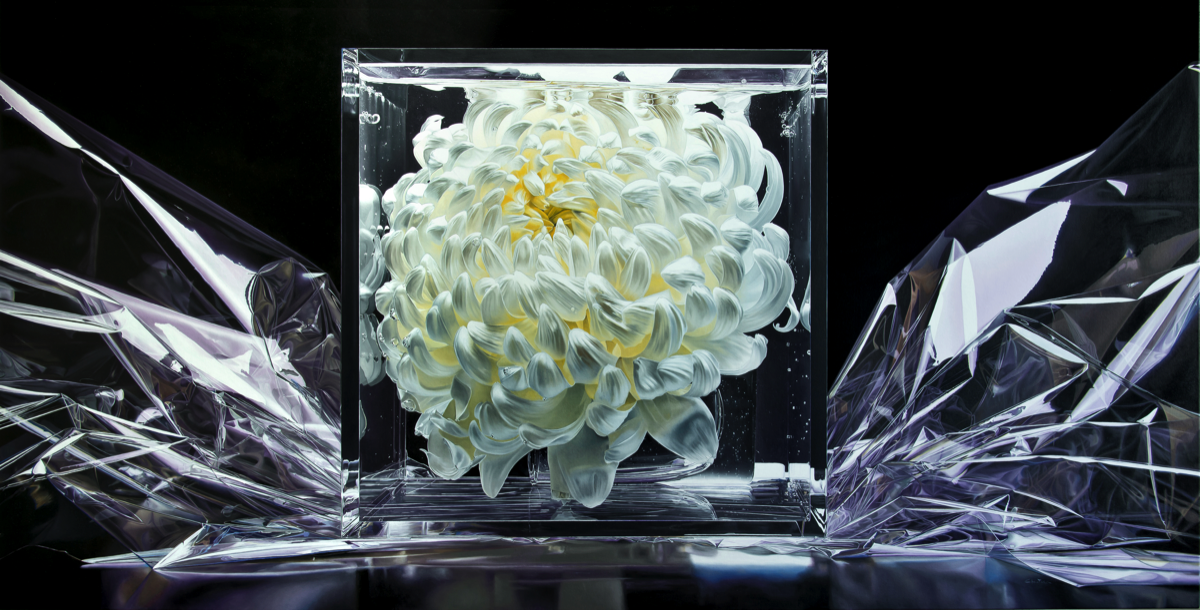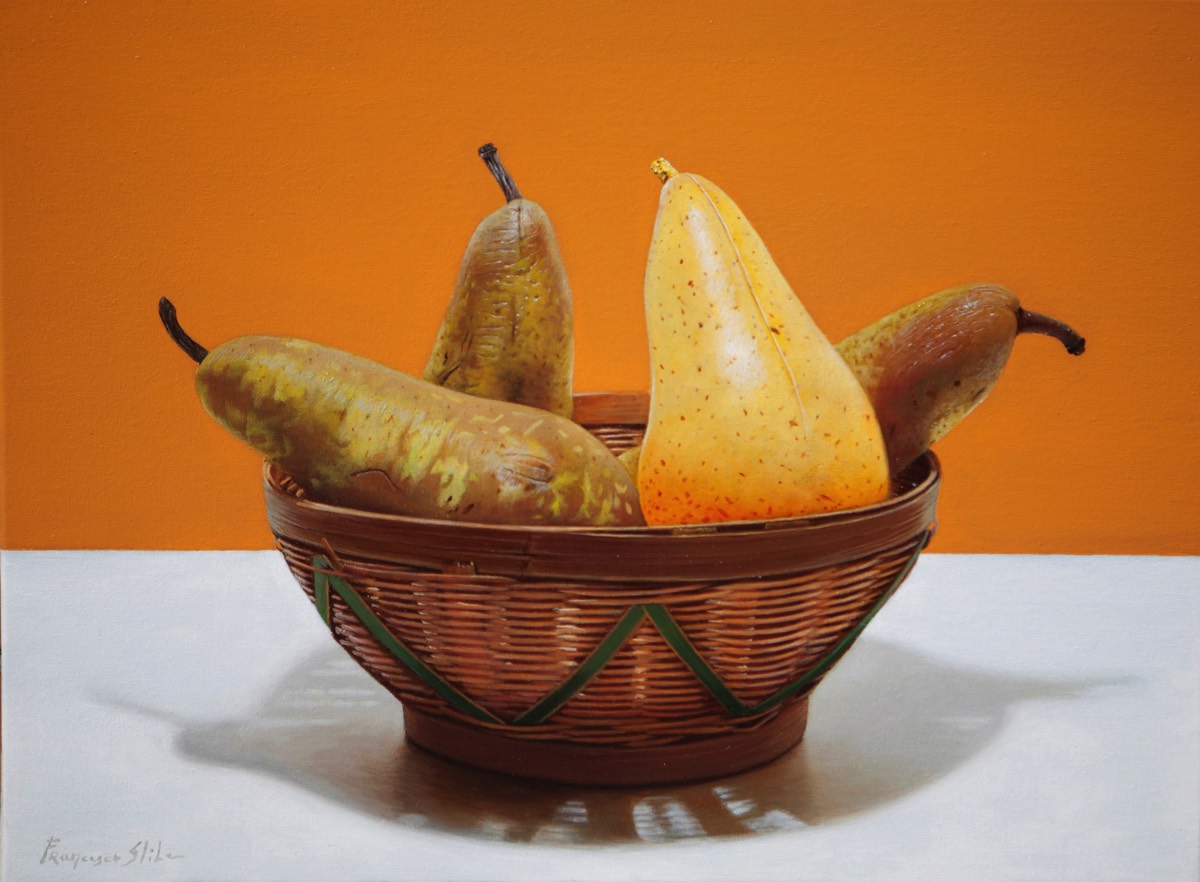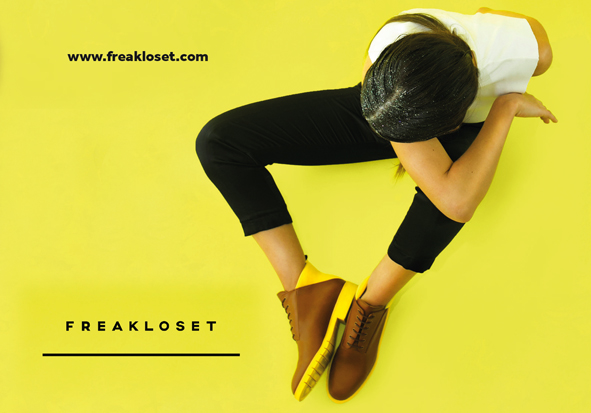ART
Surrey’s Premier Lifestyle Magazine
Advocate of hyperrealism
Plus One Gallery founders Maggie Bollaert and Colin Pettit were drawn to art that was precise and meticulous, rejecting the fashion for conceptualism. Having recently relocated to Battersea Reach, Plus One now seeks out artists from around the world and champions hyperrealism art. Andrew Peters peeked through the door of this innovative gallery.

Precious by Francois Chartier Oil on canvas 106 x 214 cm
How do you define the term ‘hyperrealism’ which is not universally understood outside the world of collectors and connoisseurs? Clive Head, British artist and curator of the first in a series of exhibitions at Plus One Gallery in 2008 christened the initial show ‘Exactitude’ and called it a figurative art form of “breathtaking precision and remarkable clarity.”
Maggie Bollaert and Colin Pettit, who founded Plus One in 2001, travelled to New York to visit major galleries at the forefront of the movement showing photorealism, as it was then known. Here they met and discussed the art with such luminaries in the art world as the renowned Ivan Karp at OK Harris Gallery, as well as Louis K. Meisel, to learn from the experience and widen their own knowledge.
Hyperrealist painters depict textures, spaces and detail with astonishing creative skill and technical virtuosity. Their subjects can be humble as a frankfurter, Coke can, choc bar or gaudy wrapper de rigueur, or as grandiose as a vast cityscape, underwater nymph or life-size portrait, as cinematic as a downtown diner or a lonely automobile on a deserted highway.
So how did hyperrealism evolve? Flashback to sixties’ New York City and east coast San Francisco for the birth of photorealism, and home to a series of twentieth century ‘isms’ echoing around the world.
Photorealism led to hyperrealism and, as Maggie Bollaert affirms, the origin of this genre art goes back ‘in an unbroken line’ to the earliest realist masters of the seventeenth century Dutch Golden Age.
The late, great art dealer Ivan Karp and mentor to many originally spearheaded the movement with legendary dealer Lou Castelli and later in his own eponymous gallery in Soho, New York. For the next 45 years Karp was described by the New York Times as “New York’s deftest and most enthusiastic salesman of the new art.” He helped find, popularise and market Pop Art, including Andy Warhol, Roy Lichtenstein and Robert Rauschenberg (currently winning raves for a retrospective at Tate Modern until April).
Maggie Bollaert and Colin Pettit, who founded Plus One in 2001, travelled to New York to visit major galleries at the forefront of the movement showing photorealism, as it was then known. Here they met and discussed the art with such luminaries in the art world as the renowned Ivan Karp at OK Harris Gallery, as well as Louis K. Meisel, to learn from the experience and widen their own knowledge.
Hyperrealist painters depict textures, spaces and detail with astonishing creative skill and technical virtuosity. Their subjects can be humble as a frankfurter, Coke can, choc bar or gaudy wrapper de rigueur, or as grandiose as a vast cityscape, underwater nymph or life-size portrait, as cinematic as a downtown diner or a lonely automobile on a deserted highway.
So how did hyperrealism evolve? Flashback to sixties’ New York City and east coast San Francisco for the birth of photorealism, and home to a series of twentieth century ‘isms’ echoing around the world.
Photorealism led to hyperrealism and, as Maggie Bollaert affirms, the origin of this genre art goes back ‘in an unbroken line’ to the earliest realist masters of the seventeenth century Dutch Golden Age.
The late, great art dealer Ivan Karp and mentor to many originally spearheaded the movement with legendary dealer Lou Castelli and later in his own eponymous gallery in Soho, New York. For the next 45 years Karp was described by the New York Times as “New York’s deftest and most enthusiastic salesman of the new art.” He helped find, popularise and market Pop Art, including Andy Warhol, Roy Lichtenstein and Robert Rauschenberg (currently winning raves for a retrospective at Tate Modern until April).

Painted pears, L Integrazione, Oil on canvas,30 x 40 cm by Francesco Stile
Profile: Plus One Gallery
Plus One Gallery began trading in 2001 in Marylebone, moved to Pimlico Road in 2006, and last year relocated to the vast St George development at Battersea Reach. The gallery is built on several levels, in a dazzling modern design, with white walls, pale timber floors and large windows, creating an atmosphere of light and air.When owner-founders Maggie Bollaert and Colin Pettit started to plan their gallery, they did not have a strong focus on the type of art they wanted to handle. They were drawn towards art that was precise and meticulous: conceptual art held no attractions, only works with a lifelike quality. They knew they wanted to work with living artists and to sell only ‘truly contemporary art’.
After crystallising their ideas by talking to dynamic far-sighted leaders of the New York modern art scene, those erudite gallery owners who brought Pop Art and photorealism to the world in the sixties and seventies, they have become dedicated to the discovery and promotion of hyperrealist artists, whom Maggie seeks out around the world. Maggie believes in the increasing importance of hyperrealism (could it succeed conceptualism as the Next Big Thing?) to investors and collectors.
The Walker Gallery Liverpool, BBK Gallery in Bilbao and Museo del Tabac Andorra all held hyperrealist exhibitions in 2015. Three of Maggie’s artists are BP Award winners and are represented in the National Portrait Gallery: Craig Wylie, Philip Harris and Andrew Tift. Sculptor Paul Day won a competition to produce the Queen Mother’s Memorial in the Mall and
his Battle of Britain relief has been installed on the Embankment.
Hyperrealism has given the gallery a strong identity. Maggie explains that for her one of the compelling attractions of hyperrealism is: “the connection with different art movements of the past, such as Dutch still lifes of the Golden Age and American Pop Art.”
Plus One Gallery is widely recognised as the show place for hyperrealism from all parts of the world. In stock is art from the best of the original American photorealists, as well as work from artists based in Europe, Latin America and the Far East.
The gallery has remained pure in its endeavours to promote realism in all its many aspects and has become a destination point for artists and collectors alike.
Karp made the New York Soho district come alive, opening up a decrepit neighbourhood and making it world famous. He played a fundamental role in discovering and promoting hyperrealist painting, following on from photorealism. He actively promoted major exponents of the new art such as Ralph Goings, Robert Bechtle, Richard Estes, Chuck Close and John Salt.
Karp as scholar and historian attempts to analyse hyperrealism. What was the spark that set it alight, what do hyperrealist painters have in common, what direction are today’s realists taking?
As he explained: “Hyperrealism is related to minimalism, but is bereft of intellectual pretensions. At its best it is starkly ‘matter of fact’, ‘anti sensibility’. Its realism records the previously unrecorded places and objects of everyday life. Humanity is rarely in evidence.”
Over the past four decades, art dealer and author Louis K. Meisel has also worked assiduously to champion mainly American photorealism, a term he claims to have coined in the late sixties with it first appearing in print in 1969. In 1970, the first show of the decade at the Whitney Museum of American Art was ‘22 Realists’ and the catalogue foreword also used the word ‘photorealism.’ That was the beginning.
Meisel describes the roots of photorealism as: “The photo realists made it legitimate to use the camera again after artists had rejected it, saying they didn’t need realism to document faces, places and things because the camera can record it. There were great realist painters before who recorded early twentieth century American urban life and landscape with emotional truth. Among them are Thomas Eakins, Edward Hopper, and Winslow Homer, who denied using the camera, or didn’t want to talk about it or admit it. It didn’t become acceptable for an artist to say, ‘Hey, the camera and photograph are tools, and we’re using them’ until the photorealists came along in the nineteen seventies. Artists influenced photographers, photographers artists. The camera influenced everybody.”
The new genre became a movement and many of the first photorealists grouped together and became friends. Robert Bechtle took a picture of himself in the mirror with a car outside, and then painted it. A contemporary, Audrey Flack, used a picture out of a magazine and painted it. That was ‘Kennedy Motorcade’ taken from a 1963 news photo. John Salt photographed abandoned car wrecks and then made a painting of his image. Nobody taught them to do it. It all just evolved as they went along. The birth of the instant camera became a tool for artists to snap away at images from which they gained inspiration. How they turned that inspiration into a painting was each artist’s own calling. What they shared was the excitement of a new way of finding inspiration and depicting the world in which they lived at that time.
Karp as scholar and historian attempts to analyse hyperrealism. What was the spark that set it alight, what do hyperrealist painters have in common, what direction are today’s realists taking?
As he explained: “Hyperrealism is related to minimalism, but is bereft of intellectual pretensions. At its best it is starkly ‘matter of fact’, ‘anti sensibility’. Its realism records the previously unrecorded places and objects of everyday life. Humanity is rarely in evidence.”
Over the past four decades, art dealer and author Louis K. Meisel has also worked assiduously to champion mainly American photorealism, a term he claims to have coined in the late sixties with it first appearing in print in 1969. In 1970, the first show of the decade at the Whitney Museum of American Art was ‘22 Realists’ and the catalogue foreword also used the word ‘photorealism.’ That was the beginning.
Meisel describes the roots of photorealism as: “The photo realists made it legitimate to use the camera again after artists had rejected it, saying they didn’t need realism to document faces, places and things because the camera can record it. There were great realist painters before who recorded early twentieth century American urban life and landscape with emotional truth. Among them are Thomas Eakins, Edward Hopper, and Winslow Homer, who denied using the camera, or didn’t want to talk about it or admit it. It didn’t become acceptable for an artist to say, ‘Hey, the camera and photograph are tools, and we’re using them’ until the photorealists came along in the nineteen seventies. Artists influenced photographers, photographers artists. The camera influenced everybody.”
The new genre became a movement and many of the first photorealists grouped together and became friends. Robert Bechtle took a picture of himself in the mirror with a car outside, and then painted it. A contemporary, Audrey Flack, used a picture out of a magazine and painted it. That was ‘Kennedy Motorcade’ taken from a 1963 news photo. John Salt photographed abandoned car wrecks and then made a painting of his image. Nobody taught them to do it. It all just evolved as they went along. The birth of the instant camera became a tool for artists to snap away at images from which they gained inspiration. How they turned that inspiration into a painting was each artist’s own calling. What they shared was the excitement of a new way of finding inspiration and depicting the world in which they lived at that time.
The creation of work that is ultra perfection is labour intensive and to achieve this degree of high definition work means most of the artists could only produce very few perfect paintings a year. Some, in fact, can and still do only produce work that can take much more than a year to produce a single work of art to the exacting standards they impose on themselves. Collectors bought them because they liked the paintings to look at, to take home, hang on the wall and view. To see a perfect image in paint is fascinating and although it is a ‘real image’, it possesses an almost surreal quality that stands the test of time and endures.
The most fascinating aspect of hyperrealism is its return (perhaps not intentional) to the seventeenth century masters of the Dutch Golden Age. Most scholars agree that Vermeer, one of the most sublime painters the world has ever known, though he barely made ends meet in his own lifetime, used the camera obscura (a sort of precursor of the modern photographic camera) as an aid to his painting. Artists in that time also used perspective manuals, drawing frames and almost any form of technology or scientific knowledge which might help them achieve one of their prime objectives: the highest degree of mimetic illusion. Realism, with its roots so firmly embedded in Europe with the Dutch masters, and to Germany and Middle Europe, has a rich history of highly realistic art that almost defies definition.
Plus One Gallery today has sought out the very best in European hyperrealist art, as well as American, and now shows art from all corners of the world, but always with the common theme of highly realistic perfect art. In short, Exactitude in all its many forms and widely ranging subject matters.
But technical devices, such as today’s high digital cameras, computer graphics and virtual reality simulation, are only tools. The creation of a work of art is always, said Ivan Karp: “ineffable, a kind of miracle no matter what the process or equipage.”
The extraordinary powers of these hyperrealist artists cannot be explained by training or apprenticeships, the most plausible and yet simple explanation is a ‘blessing of nature’.
Critics have tried to explain the essence of hyperrealism in a few words, using neat phrases such as an “embellished, heightened sense of reality” or “a layer of vision that would otherwise remain unseen.”
So, ‘exactitude’ with a small ‘e’ has played an important part in art history, ever since the discovery of perspective. Writer on fine art and cinema, John Russell Taylor, describing the origins of realism in the definitive book ‘Exactitude: Hyperrealistic Art Today’, reminds us that even before Vermeer, Aristotle in fourth century BC knew all about the camera obscura, so everything goes back to the Greeks, yet again.
Plus One Gallery is still at the forefront of the ever growing and evolving movement promoting the very best of realism in all its forms and its list of artists continues to grow, as do the ranks of discerning collectors. It is a continuing project that constantly changes, can never be out of date and is a chronicle of life itself.
The most fascinating aspect of hyperrealism is its return (perhaps not intentional) to the seventeenth century masters of the Dutch Golden Age. Most scholars agree that Vermeer, one of the most sublime painters the world has ever known, though he barely made ends meet in his own lifetime, used the camera obscura (a sort of precursor of the modern photographic camera) as an aid to his painting. Artists in that time also used perspective manuals, drawing frames and almost any form of technology or scientific knowledge which might help them achieve one of their prime objectives: the highest degree of mimetic illusion. Realism, with its roots so firmly embedded in Europe with the Dutch masters, and to Germany and Middle Europe, has a rich history of highly realistic art that almost defies definition.
Plus One Gallery today has sought out the very best in European hyperrealist art, as well as American, and now shows art from all corners of the world, but always with the common theme of highly realistic perfect art. In short, Exactitude in all its many forms and widely ranging subject matters.
But technical devices, such as today’s high digital cameras, computer graphics and virtual reality simulation, are only tools. The creation of a work of art is always, said Ivan Karp: “ineffable, a kind of miracle no matter what the process or equipage.”
The extraordinary powers of these hyperrealist artists cannot be explained by training or apprenticeships, the most plausible and yet simple explanation is a ‘blessing of nature’.
Critics have tried to explain the essence of hyperrealism in a few words, using neat phrases such as an “embellished, heightened sense of reality” or “a layer of vision that would otherwise remain unseen.”
So, ‘exactitude’ with a small ‘e’ has played an important part in art history, ever since the discovery of perspective. Writer on fine art and cinema, John Russell Taylor, describing the origins of realism in the definitive book ‘Exactitude: Hyperrealistic Art Today’, reminds us that even before Vermeer, Aristotle in fourth century BC knew all about the camera obscura, so everything goes back to the Greeks, yet again.
Plus One Gallery is still at the forefront of the ever growing and evolving movement promoting the very best of realism in all its forms and its list of artists continues to grow, as do the ranks of discerning collectors. It is a continuing project that constantly changes, can never be out of date and is a chronicle of life itself.
essence info
Plus One GalleryB & C Trafalgar House, Juniper Drive, Battersea Reach, York Road, London SW18 1GY
Website: www.plusonegallery
Winter exhibition from 25 January to 25 February 2017
Plus One Publishing is responsible for Exactitude and several books dedicated to specific artists and their work.
GROWTH OF ONLINE MEANS THE DEATH OF THE PRINTED CATALOGUE
Ten major trends evident from 2016
Barnebys, the leading search engine aggregator for art and antique auctions, covering 1,600 auction houses and carrying half a million objects at any one time, has taken a snapshot of the 2016, highlighting trends.
1. The increasing importance of online bidding. Anecdotal as well as researched evidence with leading international auction houses shows that on average some 35% of bids now come in over the internet.
2. The widening of users of online bidding to include younger wealthy buyers. A new generation is logging on to buy instead of searching the high stree, so we can expect growth among the millennials. When it comes to the volume market, they will be central to its growth, motivated in part by quality and also the environmental aspect of buying on the second-hand (i.e. auction) market. Recycling is going beyond cans and bottles – and it has ever greater strength. Auction houses and antique dealers offer millennials qualities that appeal to them – environmental sensitivity as well as quality, durability and sustainability.
3. And partly as a result of this online revolution, auctioneers are cutting back on the numbers of catalogues they print – some are doing without catalogues at all, using online catalogues.
4. Art market fluctuates. The Chinese market is significantly down, while the US art market is stronger than it has been for some years.
5. While the very top of the market performed strongly, auction houses are increasingly looking at the middle and lower market where commissions are not under so much pressure to make up for losses at the top end. But, as always, the best and most unique items are still achieving huge prices not seen since 1990 and before the 2008 crash. The middle segment of the market is currently struggling. The lower end survives and grows as auction houses reach out to a whole new audience via social media and the internet.
6. Emerging art markets: China, Africa and Latin America. Interest in Chinese contemporary art continues to grow, but the real excitement for new ‘investors’ rather than collectors
is in contemporary African art, Latin American art, Indian contemporary art and Cuban art. There will be an increasing focus on African art, which will include sculptures, with some emerging regions more interesting than others to follow. Currently artists from South Africa, Nigeria and Ghana lead the market with auction results. The market will be more and more aware that Africa is not a country, it’s a continent of 54 countries.
7. Demand for twentieth century design has been growing since the late 1990s. But it is now really sought after and world record prices are being achieved.
8. The provenance of an item becomes ever more important as celebrity connections add value. During 2016 we saw a lot of ‘white glove’ auctions, especially celebrity-led sales or collections of famous people. That will continue to grow and increase in revenue.
9. Collectables such as watches, coins and classic cars, areas that win on globalisation and increased online bidding will continue to grow.
10. Female artists. The search for new names and the best works continues to grow. The high prices for female artists who have written the history of art in their own time will be central to future museum exhibitions.
“Artists influenced photographers, photographers artists. The camera influenced everybody”
Louis K. Meisel



